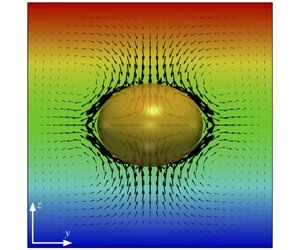Published online by Cambridge University Press: 27 April 2020

Transient electrohydrodynamics of a liquid drop at finite Reynolds numbers is studied by computer simulations. The governing equations of the problem are solved using a parallelized front tracking/finite difference method in the framework of the Taylor–Melcher leaky dielectric theory. The effect of the dielectric properties of the fluids on the dynamic response of the drop is studied by considering three representative fluid systems, which encompass all the regions of the deformation–circulation map. A parametric study is performed over a range of capillary number  $Ca$, the Ohnesorge number squared
$Ca$, the Ohnesorge number squared  $Oh^{2}$ and the viscosity ratio
$Oh^{2}$ and the viscosity ratio  $\widetilde{\unicode[STIX]{x1D707}}$ to explore the effect of these parameters on the dynamic response. At low to intermediate capillary numbers, the dynamic response resembles that of a first- or second-order mechanical system, where the deformation settles to a steady state monotonically or through oscillations. However, beyond a threshold capillary number, the dynamic response becomes nonlinear. It is shown that the Ohnesorge number squared
$\widetilde{\unicode[STIX]{x1D707}}$ to explore the effect of these parameters on the dynamic response. At low to intermediate capillary numbers, the dynamic response resembles that of a first- or second-order mechanical system, where the deformation settles to a steady state monotonically or through oscillations. However, beyond a threshold capillary number, the dynamic response becomes nonlinear. It is shown that the Ohnesorge number squared  $Oh^{2}$ and the viscosity ratio
$Oh^{2}$ and the viscosity ratio  $\widetilde{\unicode[STIX]{x1D707}}$ are the key parameters that determine the transition from a monotonic response to an oscillatory one (and vice versa) in density-matched fluid systems. To predict the dynamic response of nearly spherical drops at arbitrary
$\widetilde{\unicode[STIX]{x1D707}}$ are the key parameters that determine the transition from a monotonic response to an oscillatory one (and vice versa) in density-matched fluid systems. To predict the dynamic response of nearly spherical drops at arbitrary  $Oh^{2}$, an analytical equation is developed, which results in a critical Ohnesorge number squared
$Oh^{2}$, an analytical equation is developed, which results in a critical Ohnesorge number squared  $Oh_{c}^{2}$ that demarks a monotonic response from an oscillatory one. Investigations on the effect of the viscosity ratio
$Oh_{c}^{2}$ that demarks a monotonic response from an oscillatory one. Investigations on the effect of the viscosity ratio  $\widetilde{\unicode[STIX]{x1D707}}$ on the dynamic response shows that the relaxation time (for monotonic response) increases with an increase in
$\widetilde{\unicode[STIX]{x1D707}}$ on the dynamic response shows that the relaxation time (for monotonic response) increases with an increase in  $\widetilde{\unicode[STIX]{x1D707}}$ and that the steady state deformation
$\widetilde{\unicode[STIX]{x1D707}}$ and that the steady state deformation  ${\mathcal{D}}_{ss}$ correlates positively with
${\mathcal{D}}_{ss}$ correlates positively with  $\widetilde{\unicode[STIX]{x1D707}}$ for oblate drops; however, depending on the corresponding regions of prolate drops on the deformation–circulation map,
$\widetilde{\unicode[STIX]{x1D707}}$ for oblate drops; however, depending on the corresponding regions of prolate drops on the deformation–circulation map,  ${\mathcal{D}}_{ss}$ correlates positively or negatively with
${\mathcal{D}}_{ss}$ correlates positively or negatively with  $\widetilde{\unicode[STIX]{x1D707}}$. A long-standing misconception regarding the oblate region is also rectified by development of a normal stress map, which determines the relative importance of the electric pressure and the normal hydrodynamic stress in setting the sense of the deformation of the drop.
$\widetilde{\unicode[STIX]{x1D707}}$. A long-standing misconception regarding the oblate region is also rectified by development of a normal stress map, which determines the relative importance of the electric pressure and the normal hydrodynamic stress in setting the sense of the deformation of the drop.